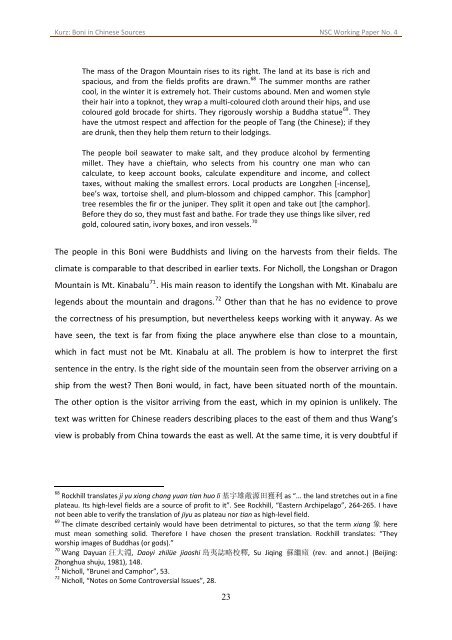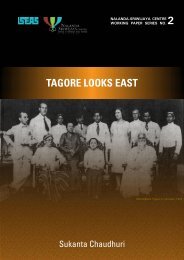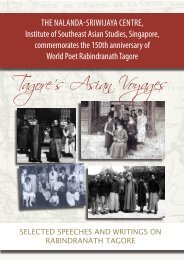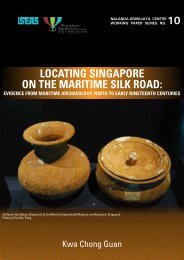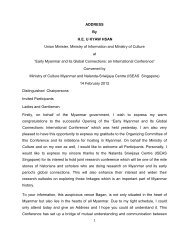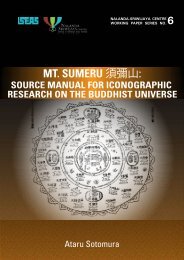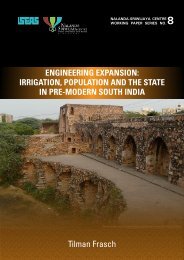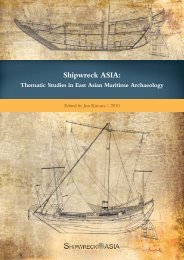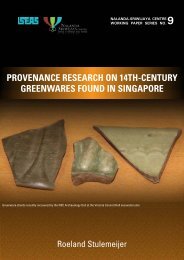Boni in Chinese Sources - Nalanda-Sriwijaya Centre - iseas
Boni in Chinese Sources - Nalanda-Sriwijaya Centre - iseas
Boni in Chinese Sources - Nalanda-Sriwijaya Centre - iseas
Create successful ePaper yourself
Turn your PDF publications into a flip-book with our unique Google optimized e-Paper software.
Kurz: <strong>Boni</strong> <strong>in</strong> Ch<strong>in</strong>ese <strong>Sources</strong> NSC Work<strong>in</strong>g Paper No. 4The mass of the Dragon Mounta<strong>in</strong> rises to its right. The land at its base is rich andspacious, and from the fields profits are drawn. 68 The summer months are rathercool, <strong>in</strong> the w<strong>in</strong>ter it is extremely hot. Their customs abound. Men and women styletheir hair <strong>in</strong>to a topknot, they wrap a multi‐coloured cloth around their hips, and usecoloured gold brocade for shirts. They rigorously worship a Buddha statue 69 . Theyhave the utmost respect and affection for the people of Tang (the Ch<strong>in</strong>ese); if theyare drunk, then they help them return to their lodg<strong>in</strong>gs.The people boil seawater to make salt, and they produce alcohol by ferment<strong>in</strong>gmillet. They have a chiefta<strong>in</strong>, who selects from his country one man who cancalculate, to keep account books, calculate expenditure and <strong>in</strong>come, and collecttaxes, without mak<strong>in</strong>g the smallest errors. Local products are Longzhen [‐<strong>in</strong>cense],bee’s wax, tortoise shell, and plum‐blossom and chipped camphor. This [camphor]tree resembles the fir or the juniper. They split it open and take out [the camphor].Before they do so, they must fast and bathe. For trade they use th<strong>in</strong>gs like silver, redgold, coloured sat<strong>in</strong>, ivory boxes, and iron vessels. 70The people <strong>in</strong> this <strong>Boni</strong> were Buddhists and liv<strong>in</strong>g on the harvests from their fields. Theclimate is comparable to that described <strong>in</strong> earlier texts. For Nicholl, the Longshan or DragonMounta<strong>in</strong> is Mt. K<strong>in</strong>abalu 71 . His ma<strong>in</strong> reason to identify the Longshan with Mt. K<strong>in</strong>abalu arelegends about the mounta<strong>in</strong> and dragons. 72 Other than that he has no evidence to provethe correctness of his presumption, but nevertheless keeps work<strong>in</strong>g with it anyway. As wehave seen, the text is far from fix<strong>in</strong>g the place anywhere else than close to a mounta<strong>in</strong>,which <strong>in</strong> fact must not be Mt. K<strong>in</strong>abalu at all. The problem is how to <strong>in</strong>terpret the firstsentence <strong>in</strong> the entry. Is the right side of the mounta<strong>in</strong> seen from the observer arriv<strong>in</strong>g on aship from the west? Then <strong>Boni</strong> would, <strong>in</strong> fact, have been situated north of the mounta<strong>in</strong>.The other option is the visitor arriv<strong>in</strong>g from the east, which <strong>in</strong> my op<strong>in</strong>ion is unlikely. Thetext was written for Ch<strong>in</strong>ese readers describ<strong>in</strong>g places to the east of them and thus Wang’sview is probably from Ch<strong>in</strong>a towards the east as well. At the same time, it is very doubtful if68 Rockhill translates ji yu xiong chang yuan tian huo li 基 宇 雄 敞 源 田 獲 利 as “... the land stretches out <strong>in</strong> a f<strong>in</strong>eplateau. Its high‐level fields are a source of profit to it”. See Rockhill, “Eastern Archipelago”, 264‐265. I havenot been able to verify the translation of jiyu as plateau nor tian as high‐level field.69 The climate described certa<strong>in</strong>ly would have been detrimental to pictures, so that the term xiang 象 heremust mean someth<strong>in</strong>g solid. Therefore I have chosen the present translation. Rockhill translates: “Theyworship images of Buddhas (or gods).”70 Wang Dayuan 汪 大 淵 , Daoyi zhilüe jiaoshi 島 夷 誌 略 校 釋 , Su Jiq<strong>in</strong>g 蘇 繼 廎 (rev. and annot.) (Beij<strong>in</strong>g:Zhonghua shuju, 1981), 148.71 Nicholl, “Brunei and Camphor”, 53.72 Nicholl, “Notes on Some Controversial Issues”, 28.23


